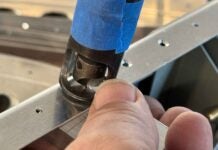Tungsten
In Eric Stewart’s article, “Titans of Tungsten” [November 2018], he mentioned using tungsten as a counterweight because it is 1.5 times denser than lead. If there is adequate room for a lead counterweight, why spend the money for tungsten? Either way, both materials will need to be the same weight to be effective. Am I missing something?
—Joe Connell
You have it right. In the case of the plane that Eric is building, space is extremely tight, and every fraction of an inch counts, so tungsten won out over a larger (but equal weight) piece of lead.—Ed.
Ice!
I really enjoyed Nigel Speedy’s article about ice tests [RV-8 on Ice, July 2018]. I fly an RV-4 in the Pacific Northwest, and it is almost impossible to be in IMC and not be at or near freezing during most of the year. I have actually picked up a little ice in the middle of summer flying over the Cascades.
That being said, there is one episode in particular that stands out. I flew to the Pullman-Moscow Airport one winter day to pick up my daughter who was going to college there. It was clear at my home airport in Coeur d’Alene, Idaho, and ice was not in the forecast. When I got close to the destination, it was apparent I would have to do the VOR approach since the airport was covered by low clouds.
On final approach, I entered the clouds and began to pick up a significant amount of ice. I decided to continue the approach because I knew clear conditions were close by. When I broke out of the clouds, I had about 1/2 to 3/4 inch of ice on the leading edge of the wings. I also noticed during the descent that I had to add power to keep the descent rate the same as I normally use without ice. Another interesting thing is that my prop blades were shedding ice on a random basis, causing some vibration. Ice also collected on the windscreen, eliminating forward visibility.
I was able to find the runway by gently weaving left and right, and looking out the sides of the canopy. I also kept the speed up and did not lower the flaps as the airplane was flying fine in its current configuration. My reason for not putting the flaps down was that I did not know what it would fly like in a different configuration, so why change it?
When I was near the runway, I was able to tell the height by looking forward and using peripheral vision, working my way down until I was seeing the runway lights going by. I was still a little fast, so I did a wheel landing. The RV-4 is a tandem-seat airplane, so you can see out both sides equally, and this worked well. I am not sure the result would have been the same in a side-by-side.
When I landed, there was between 1/2 to 3/4 inch of ice on the leading edges of the wings and tail, and about 3/8 to 1/2 inch of ice on the leading edge of the prop blades. Of course, there was also ice on the windscreen.
Thanks for a great article; please keep them coming!
—Brent Travis
UMA Instruments
I really enjoyed Don Maxwell’s article about UMA Instruments [November, 2018] and the people who work there. Please give him my thanks.
—Mark Burns
Write to editorial@kitplanes.com.













